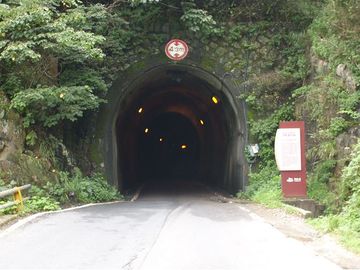"여수 마래 제2터널"의 두 판 사이의 차이
(→새로운 영문) |
|||
| (다른 사용자 한 명의 중간 판 하나는 보이지 않습니다) | |||
| 1번째 줄: | 1번째 줄: | ||
| − | |||
{{문화유산정보 | {{문화유산정보 | ||
|사진=여수마래제2터널.jpg | |사진=여수마래제2터널.jpg | ||
| 36번째 줄: | 35번째 줄: | ||
'''Marae Tunnel No. 2, Yeosu''' | '''Marae Tunnel No. 2, Yeosu''' | ||
| − | + | Marae Tunnel No. 2 was built in 1926 for military use during the Japanese colonial period (1910-1945). It is the only tunnel for vehicle passage in Korea built in a rock stratum. It is a one-lane tunnel measuring 640 m in length with five emergency stopping points each located 100 m apart. | |
| − | |||
| − | + | It is said that many Chinese workers were employed in the construction of this tunnel. Because the work was done only with iron hammers and chisels, the walls and the ceiling of the tunnel were left unfinished with an uneven and jagged surface. | |
| − | + | Next to this tunnel is Marae Tunnel No. 1, which was built to store the rice provisions of the Japanese Imperial Army. | |
| − | |||
| − | |||
| − | |||
| − | |||
| − | |||
| − | |||
| − | |||
| − | |||
| − | |||
| − | Next to this tunnel is Marae Tunnel No. 1, which was built to store the rice provisions of the Japanese Imperial Army. | ||
| − | |||
| − | |||
| − | |||
| − | |||
===영문 해설 내용=== | ===영문 해설 내용=== | ||
| − | 마래 제2터널은 군사 도로로 사용하기 위해 일제강점기인 1926년에 지어졌다. 한국에서 유일하게 자연 암반을 뚫어 차량이 통행할 수 있게 만든 터널이다. 640m 길이의 대규모 1차선 도로이고, 터널 안에는 약 100m 간격으로 차량 대기용 공간이 5곳 있다. | + | 마래 제2터널은 군사 도로로 사용하기 위해 일제강점기인 1926년에 지어졌다. 한국에서 유일하게 자연 암반을 뚫어 차량이 통행할 수 있게 만든 터널이다. 640m 길이의 대규모 1차선 도로이고, 터널 안에는 약 100m 간격으로 차량 대기용 공간이 5곳 있다. |
| − | 이 터널의 공사에는 수많은 중국인 노동자들이 동원되었다고 한다. 건설 당시 쇠망치와 정으로 암반을 뚫었는데, 미처 마감을 못해 벽과 천정은 울퉁불퉁한 상태이다. | + | 이 터널의 공사에는 수많은 중국인 노동자들이 동원되었다고 한다. 건설 당시 쇠망치와 정으로 암반을 뚫었는데, 미처 마감을 못해 벽과 천정은 울퉁불퉁한 상태이다. |
바로 옆에는 일제가 군량미 창고로 쓰기 위해 설계한 마래 제1터널이 있다. | 바로 옆에는 일제가 군량미 창고로 쓰기 위해 설계한 마래 제1터널이 있다. | ||
2021년 10월 4일 (월) 14:50 기준 최신판
| 여수 마래 제2터널 Marae Tunnel No. 2, Yeosu |
|
 여수 마래 제2터널, 국가문화유산포털, 문화재청. |
|
| 대표명칭 | 여수 마래 제2터널 |
|---|---|
| 영문명칭 | Marae Tunnel No. 2, Yeosu |
| 한자 | 麗水 馬來 第二터널 |
| 주소 | 전라남도 여수시 덕충동 산7-3번지 외 6필지 |
| 국가유산 종목 | 국가등록문화재 제116호 |
| 지정(등록)일 | 2004년 12월 31일 |
| 분류 | 등록문화재/기타/공공용시설 |
| 시대 | 일제강점기 |
| 수량/면적 | 연장 640m, 폭원 4.5m, 높이 4.5m |
| 웹사이트 | 여수 마래 제2터널, 국가문화유산포털, 문화재청. |
해설문
국문
여수 마래 제2터널은 군사 도로로 사용하기 위해 1926년 지어진 터널이다. 국내에서는 유일하게 차량 통행용으로 이용되는 자연 암반 터널로, 일제가 군량미 창고로 쓰기 위해 설계한 마래 제1터널 옆에 나란히 자리하고 있다. 640m 길이의 대규모 터널이며, 1차선 도로로 중간 중간 차량 대기용 공간이 있다.
이 터널 공사와 관련된 자료는 아직 발견되지 않았으나, 수많은 중국인 노동자들이 공사에 동원되었다고 한다. 비슷한 시기인 1928년 2월 시작한 여수-광주 간 철로 개설 공사에 관한 사료인 『여수여천발전사』를 보면 당시의 상황을 간접적으로 추측할 수 있다. 그 내용은 다음과 같다.
“수십 쌍의 레일이 거미줄같이 깔려 있는 가운데 수십 대의 손수레들이 쉴 새 없이 질주하면서 흙과 돌을 나르고 터널을 뚫는 공사장에는 현지 주민뿐 아니라 푸른 옷을 입은 중국인 꾸리*들과 더러는 함경도, 평안도 사람들도 섞여 있었다. 이들이 기이한 구호를 외치며 암반에 정을 박는 모습 또한 구경거리였으며 임금은 30-40전이었다고 한다. 이들이 합숙하는 함바**에는 싸움이 그칠 날이 없었고 특히 꾸리들은 괴질에 걸려 죽어가는 자가 많았다.”
- 꾸리(coolie): 19~20세기 초 미국으로 건너온 중국·인도의 노동자를 일컫는 말로, 규범 표기는 ‘쿨리’임.
- 함바[飯場]: 토목 공사나 광산 현장에 있는 노무자 합숙소를 뜻하는 일본어에서 유래한 말로, 한국에서는 건설 현장에 임시로 지어 놓은 식당을 가리킴.
영문
Marae Tunnel No. 2, Yeosu
Marae Tunnel No. 2 was built in 1926 for military use during the Japanese colonial period (1910-1945). It is the only tunnel for vehicle passage in Korea built in a rock stratum. It is a one-lane tunnel measuring 640 m in length with five emergency stopping points each located 100 m apart.
It is said that many Chinese workers were employed in the construction of this tunnel. Because the work was done only with iron hammers and chisels, the walls and the ceiling of the tunnel were left unfinished with an uneven and jagged surface.
Next to this tunnel is Marae Tunnel No. 1, which was built to store the rice provisions of the Japanese Imperial Army.
영문 해설 내용
마래 제2터널은 군사 도로로 사용하기 위해 일제강점기인 1926년에 지어졌다. 한국에서 유일하게 자연 암반을 뚫어 차량이 통행할 수 있게 만든 터널이다. 640m 길이의 대규모 1차선 도로이고, 터널 안에는 약 100m 간격으로 차량 대기용 공간이 5곳 있다.
이 터널의 공사에는 수많은 중국인 노동자들이 동원되었다고 한다. 건설 당시 쇠망치와 정으로 암반을 뚫었는데, 미처 마감을 못해 벽과 천정은 울퉁불퉁한 상태이다.
바로 옆에는 일제가 군량미 창고로 쓰기 위해 설계한 마래 제1터널이 있다.